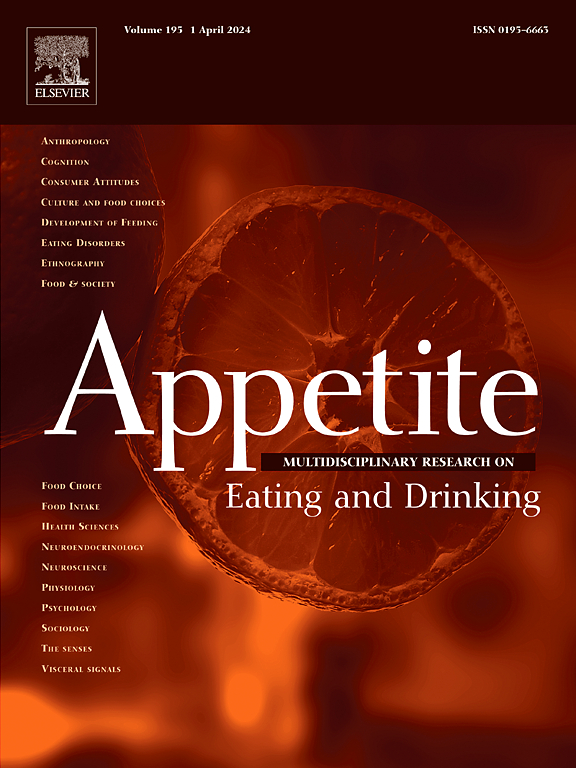Food neophobia correlates with motor cortex excitability in response to disgust-related stimuli
IF 3.8
2区 医学
Q1 BEHAVIORAL SCIENCES
引用次数: 0
Abstract
Disgust is a negative emotion that can trigger rejection mechanisms which are important for survival when the disgusting stimulus is spoiled/contaminated food. In this context the anterior digastric (AD) muscle by opening the jaw has a role in expelling potentially harmful substances from the mouth. Whether disgusting gustative stimuli affect the excitability of the primary motor cortex (M1) innervating AD muscle is not known. In this study, by applying transcranial magnetic stimulation protocol, short-interval intracortical inhibition (SICI) was measured in AD M1, during passive viewing of pictures representing either unspoiled or spoiled food. As control disgusted or happy face expressions were also administered. To evaluate a specific muscle effect, the experiment was also performed in the first dorsal interosseous (FDI) representation area in M1. Disgust sensitivity, food neophobia and adherence to Mediterranean Diet were evaluated by validated questionnaires. Results evidenced that the passive view of gustatory disgust images does not modulate the excitability of AD M1. Correlation analysis showed an enhanced cortical excitability of the M1 innervating FDI, during the passive view of spoiled food, in higher food neophobic participants. This suggests that food neophobia could facilitate recognition of disgusting/rotten food and elicit avoidance mechanisms involving the hand but not the AD, associating for the first time, the heritable trait food neophobia with differences in M1 excitability.
新食物恐惧症与运动皮层对恶心相关刺激的兴奋性相关
厌恶是一种负面情绪,可以触发排斥机制,当令人厌恶的刺激是变质/污染的食物时,这种机制对生存很重要。在这种情况下,通过打开颌骨的前二腹肌(AD)具有从口腔排出潜在有害物质的作用。恶心的味觉刺激是否会影响支配AD肌肉的初级运动皮层(M1)的兴奋性尚不清楚。在这项研究中,通过应用经颅磁刺激方案,在被动观看未变质或变质食物的图片时,测量了AD M1的短间隔皮质内抑制(SICI)。作为对照,厌恶或快乐的表情也被管理。为了评估特定的肌肉效应,实验也在M1的第一个背侧骨间(FDI)表征区进行。厌恶敏感性、新食物恐惧症和地中海饮食依从性通过有效问卷进行评估。结果证明,味觉厌恶图像的被动观不调节AD M1的兴奋性。相关分析显示,在消极看待变质食物的过程中,高食物恐惧症参与者中,支配FDI的M1皮层兴奋性增强。这表明,新食物恐惧症可以促进对恶心/腐烂食物的识别,并引发涉及手的回避机制,而不是AD,这是第一次将遗传特征食物恐惧症与M1兴奋性差异联系起来。
本文章由计算机程序翻译,如有差异,请以英文原文为准。
求助全文
约1分钟内获得全文
求助全文
来源期刊

Appetite
医学-行为科学
CiteScore
9.10
自引率
11.10%
发文量
566
审稿时长
13.4 weeks
期刊介绍:
Appetite is an international research journal specializing in cultural, social, psychological, sensory and physiological influences on the selection and intake of foods and drinks. It covers normal and disordered eating and drinking and welcomes studies of both human and non-human animal behaviour toward food. Appetite publishes research reports, reviews and commentaries. Thematic special issues appear regularly. From time to time the journal carries abstracts from professional meetings. Submissions to Appetite are expected to be based primarily on observations directly related to the selection and intake of foods and drinks; papers that are primarily focused on topics such as nutrition or obesity will not be considered unless they specifically make a novel scientific contribution to the understanding of appetite in line with the journal's aims and scope.
 求助内容:
求助内容: 应助结果提醒方式:
应助结果提醒方式:


